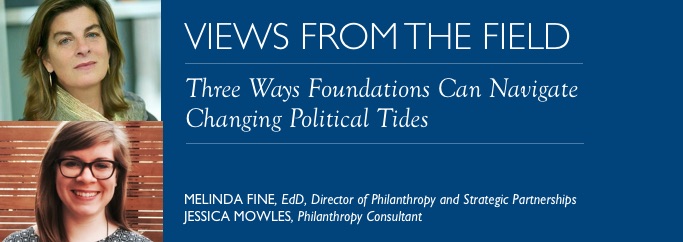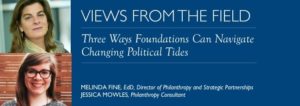
Is it on? Is it off? Is it on? Is it off? Our heads are spinning with the series of attempts to repeal the Affordable Care Act (ACA), and the numerous ways in which both the federal government and state level actors are strategizing to alter and/or erode health policy. In today’s turbulent climate, when shifting political winds and policy changes go hand-in-hand with ever-expanding health care needs across the country, how can health funders be strategically effective?
At TCC Group, a social impact consulting firm, we have been asking these questions in partnership with state, regional, and national health funders whom we have supported in strategic planning, evaluation, and capacity building work. Though contending with different state and/or local governments, demographic indicators, and health care needs, each of our foundation partners navigates a continuously dynamic environment while striving to utilize finite resources (material and otherwise) to maximize impact. In this context, we have seen foundations that vary in resource scale, strategy, and grantmaking ask similar questions:
- In today’s highly politicized climate, how should we use our voice?
- As access fluctuates, how should we think about our priority constituencies? Do roll backs in social services mandate heightened attention to particular vulnerable communities?
- How wide a net should we cast, recognizing that achieving positive health outcomes involves numerous social determinants? Which partnerships may be particularly essential in these times?
- How can we remain strategically focused and mission aligned while also being nimble enough to respond to policy shifts that occur in real time?
- Given the politically charged atmosphere, how can we productively communicate our work and goals?
There are of course no singular or “right” ways to answer these questions; each foundation must answer them distinctively, in ways that make sense according to their respective missions, values, and capacities. This said, we have found it helpful to engage foundations in three strategic learning processes to gather timely information, tap the perspective of key stakeholders, foster consensus across differences, and enable sound strategic decision-making in complex times. Though the approaches described below are framed in terms of our conversations with health funders, we have also found them useful when partnering with foundations addressing other social challenges.
- Look outward.
Today’s health challenges are too big for any single foundation to tackle alone, whatever its resource scale. For this reason, it is essential to begin strategy development with a robust understanding of a foundation’s external environment as well as the critical actors which operate within that ecosystem. Several of our health foundation partners have found it useful to periodically take stock of their supported region’s greatest health challenges, the infrastructure that exists (or needs to be built) to address these needs, local and state political dynamics of health care policy, and the priorities and practices of peer funders (health and otherwise). Increasingly, many of our health partners are committing to direct conversation with the communities they serve, making sure that they listen to and understand the experiences, pressing needs, and priorities of those most in need. By way of example, a foundation partner advancing access to rural health care recently engaged us to hold focus groups with diverse community members (some grantees, some not) in rural regions across the state, soliciting candid reflection on residents’ diverse experiences. With another foundation partner, we held conversations with local nonprofit leaders working on issues at the intersection of health, homelessness, immigration, and civic engagement, seeking to understand the impact of state and federal policy shifts and the potential for future partnerships across issues. Another foundation engaged us to survey grantees about emerging needs in specific communities by both geography and demographic constituency. Collectively, these “outward-looking” conversations yielded valuable insights about how communities are differentially (and inequitably) impacted by health policy shifts, and how particular levers of health care access may be affected by state and/or federal funding changes. These data allowed us to jointly clarify gaps and opportunities where they could play a distinctive role. - Look inward.
In complex times when strategizing, planning, and decision-making are needed, revisiting a foundation’s guiding mission, vision, and values can help it steer a clear path forward. Some foundations have reviewed their founding mission and modified or added language to reflect new commitments or a heightened sense of urgency. Others (such as conversion foundations established with a legal charter that cannot be altered) have reaffirmed a mission commitment while initiating conversations about how the mission might be translated through new strategies to remain relevant and effective. Again and again, we have seen how internal inquiry—whether facilitated dialogue across board, staff, and other leadership bodies, or systematic review of operational systems and strategies— can help clarify which field opportunity a foundation is best positioned to tackle because of its distinctive strengths and capacity to deliver. For example, one of our foundation partners undertook an equity audit of its grantmaking practices and operational systems to determine how it could best embed new equity commitments across the institution. Another looked to its founding principles to determine a path forward. “Health is embedded everywhere: within education, immigration, environment, and so many other issues,” noted a board member of this health conversion foundation. “So where should our funding begin and end? We have to look at the needs and decide, based on our mandate, which we are best able to address.” - Look to each other.
While funders across issue areas strive to make sense of the new federal and state landscapes to remain maximally effective, health funders are arguably among those most challenged. Learning from peers about how different foundations are coping can be enormously instructive (and reassuring). In our recent work with health foundation leaders across the country, for example, we have a specific health conversion foundation board chair expressed the following sentiment: “We are passionately nonpartisan and believe that our objectivity allows us to get our message out, but how do we maintain that focus when the simple claim that everyone should have access to health care is viewed as a deeply partisan statement?” Philanthropy-serving organizations (PSOs) and affinity networks (such as Grantmakers In Health) are facilitating fruitful conversations across their diverse member bases to help funders find a safe space for candid reflection and troubleshooting. The value of convening funders, encouraging them to share best practices, and fostering their collaboration and alignment cannot be overstated in these times.
As consulting partners, we feel privileged to be working alongside diverse health funders—and their allies in intersecting fields—to support the strategic clarity and adaptation necessary in this collective moment of lightning-quick change. New conversations and alignments—with a diversity of players within and beyond a foundation’s own walls–are urgently needed to make headway together. The processes above are some ways to get started; we are eager to learn additional ideas and approaches to help ensure that the health needs of everyone, including the most vulnerable, will be met now and well into the future.

